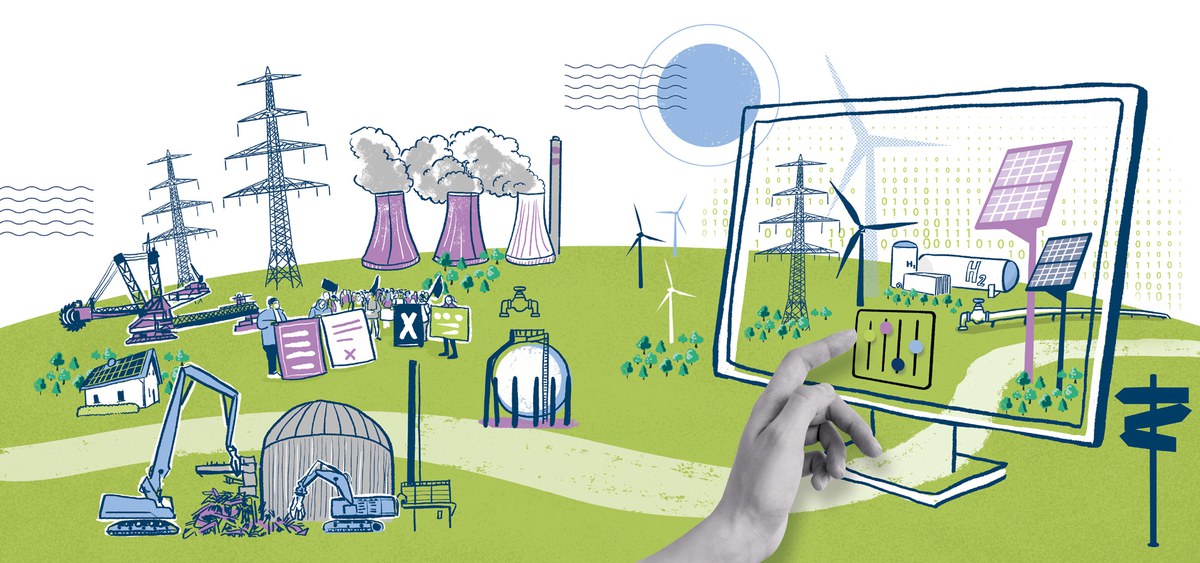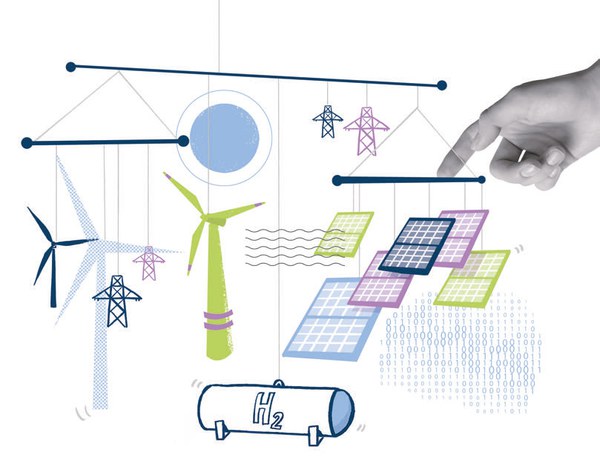Go to Online-effzett for the latest topics and background information
Energy scenarios: A glimpse into the future
Germany has committed to achieving greenhouse gas neutrality by 2045. Detailed energy scenarios outline the ways of reaching this goal – and help to identify the best possible path.

In 1972, our present remained in the distant future. But even then, people were wondering what the world might look like in over 50 years’ time. Major challenges could no longer be ignored: the global population was growing. Would there still be enough food for everyone in the future? Would the rampant exploitation of raw materials destroy nature?

Our scenario studies show that we can achieve this transformation – from both a technical as well as an economic standpoint.
In response to these questions, the Club of Rome, an association of experts from over 30 countries, published a study entitled “The Limits to Growth”. For the study, the authors used a method that had previously received little public attention, playing out various scenarios of how humanity might develop in the coming century. They based their scenarios on certain assumptions, such as population growth, agricultural efficiency, and raw material reserves. Based on these assumptions, a computer model simulated where the world was heading in future.
Such computer-assisted scenario studies have now become established whenever far-reaching decisions have to be made in politics, industry, and society. However, scenario studies do not offer predictions. Instead, they are intended to offer guidance by showing what actions might be taken within the scope of a possible solution – and how future pathways play out differently under varying boundary conditions. The Intergovernmental Panel on Climate Change (IPCC), for example, describes alternative future scenarios for the global climate in its reports, which are dependent on global CO2 emissions.
Jülich researchers use scenario techniques to look at the future of Germany’s energy supply. Germany has set itself the ambitious goal of achieving greenhouse gas neutrality by 2045 — meaning the country aims to reach net-zero emissions by that year. This goal was outlined in Germany’s Federal Climate Action Act passed in 2019. But is it achievable? Or is the energy transition in danger of petering out halfway? “Our scenario studies show that we can achieve this transformation – from both a technical as well as an economic standpoint,” says Dr. Theresa Klütz from Jülich Systems Analysis (ICE-2).
Hard and soft factors

Scenario studies follow an established pattern. “It starts with a question,” explains the researcher. “Usually on topics that are currently being discussed in politics. In our case, for example: what does Germany’s path to greenhouse gas neutrality look like?” First of all, the boundary conditions for the future development of the energy system are defined. These assumptions usually combine quantitative and qualitative aspects, hard and soft factors. Two important hard factors, for example, are population growth and economic development, expressed in terms of gross domestic product.
“The soft factors, on the other hand, are referred to as storylines,” says Prof. Heidi Heinrichs from ICE-2. “They describe the background to the scenarios and set the stage, so to speak, for the actual calculations.” For example: Will Germany continue to pursue its pro-European course? What will be the level of acceptance for certain technologies? How will planning law develop for new wind turbines? An important qualitative assumption in the Jülich studies on achieving greenhouse gas neutrality by 2045 was, for example, that current industrial sites would remain in place and that there would be no migration of industries.
All these factors in the storylines describe the context of future developments. This is why scientists refer to them as context scenarios. The selected context scenarios must be translated into raw figures, which are then fed into complex models. These figures are at the heart of the scenario studies. The researchers at ICE-2 developed the ETHOS model suite for this purpose. “Model suites, in other words model kits such as ETHOS, are pure mathematics,” says Dr. Stefan Vögele, who is head of the Socioeconomics department at ICE-2. The models contained in the suite not only incorporate key figures from the context scenarios, but also thousands of technologies and their costs, such as wind turbines, hydrogen pipelines, and large-scale energy storage facilities. They also take into account the interdependencies between these technologies.

The model used the many technologies in such a way that the lowest costs were achieved.
Not just a future
The model evaluates all this information. Since planning law and the expansion of renewables, for example, can develop in very different ways, a whole range of scenarios emerges – each of them a possible future dependent on which path the model takes. “The trick is to find the optimal path within certain parameters,” says Theresa Klütz.
In the case of a scenario in which greenhouse gas neutrality is achieved, the aim was to find the path that would incur the lowest costs. “That’s why we didn’t tell the model to simply cover energy consumption and meet certain CO2 reduction targets. We also said to look for a way to minimize costs. The model then used the many technologies – from the type of power plants to electricity grids and energy storage systems – in such a way that the lowest costs were achieved,” explains Vögele.

What would happen if...?
The researchers are thus able to determine which course of action needs to be taken and how. One clear finding of the study on achieving greenhouse gas neutrality by 2045 is that a rapid expansion of renewables is needed to meet the expected demand for electricity. The pace of this expansion also has a major impact on how much hydrogen Germany will need to import in future. This applies not only to renewables in Germany, but also its European neighbours. With the rapid expansion of wind and solar energy, the demand for hydrogen can be met by European sources alone. “There is a lot of potential for wind power in Scandinavia and the British Isles as well as for photovoltaics in southern Europe. However, this requires all EU countries to continue working together,” says Klütz. If the expansion is sluggish or European cooperation fails to work, more expensive global imports would have to supplement supplies in Germany.
If Germany sticks to the right path in terms of its energy future, electricity costs will become cheaper and more stable for everyone. However, the scenario studies also show the consequences of not staying on this path. If, for example, there is a delay to the expansion of high-voltage transmission lines transporting electricity from wind turbines on the coast to the south, this will have to be compensated for elsewhere. More plants would have to be built to produce hydrogen from renewable electricity. This energy carrier could then be used in conjunction with storage facilities to help buffer fluctuations in supply. In southern Germany, a greater expansion of other sources would be needed, particularly solar energy. However, all of this would require significant additional investment.

I hope that our scenarios will provide decision-makers with a solid scientific foundation and help contribute to the success of the energy transition.
And what are the limitations of the scenario method? “We always have to assume certain boundary conditions that give us a range of scenarios,” says Klütz. However, some developments and events cannot be predicted. “We cannot say whether industry will eventually move away from traditional locations such as North Rhine-Westphalia or the Rhine-Main region in future. But we can formulate this as a boundary condition and thus obtain an alternative future.”

In addition, unexpected events can occur such as the Russian invasion of Ukraine or framework conditions can change. For example, scenario studies for the German government’s 2010 Energy Concept assumed a 25 % reduction in electricity consumption in Germany by 2050. However, a recent scenario study by Vögele’s team has calculated that the annual electricity demand in Germany will double by 2045 compared to today’s levels.
Reduce uncertainty
The fact remains that no projections are 100 % reliable. It is impossible to say with certainty whether 90 % of Germany’s energy will really come from wind and solar power plants in 2045. However, this scenario is likely to be the most cost-effective way of achieving the climate targets. The models can be recalculated to reflect changed boundary conditions. Moreover, drastic events and their consequences can be simulated using the Jülich energy system models.
The Helmholtz platform for the design of a robust energy system and raw material supply (RESUR), for example, involves ICE-2 exploring how extreme events — such as wars, natural disasters, and severe climate phenomena — impact the energy supply. This allows conclusions to be drawn about the resilience of our energy system and reduces the uncertainty surrounding the transformation of the German energy system to the greatest extent possible. Heidi Heinrichs: “I hope that our scenarios will provide decision-makers with a solid scientific foundation and help contribute to the success of the energy transition.”
ETHOS – A modular toolbox
The model suite ETHOS (Energy Transformation PatHway Optimization Suite) was developed in-house by Jülich Systems Analysis. At its core are two large models of Germany, which are used to model how the energy supply will develop in future. One of them shows how the individual sectors of the energy system interact for the whole of Germany; the other calculates with a high spatial resolution.
Depending on the initial question, additional tools and sub-models can be added. Some of these depict energy imports, take the global market into account, or break down the energy supply into smaller units, such as individual neighbourhoods or buildings within a city. Other tools provide input data for the Germany models, such as the space available for wind and solar energy plants or weather patterns. ETHOS is thus able to analyse energy systems and optimize them in terms of costs, taking CO2 targets into account.
The data for the models come from systematic research of specialist literature and databases, explains Prof. Heidi Heinrichs from Jülich Systems Analysis (ICE-2): “We have now also started working with AI-based methods in order to keep up with the flood of publications. This allows us to keep our technology databases up to date while incorporating the latest developments.”
ETHOS has been continuously expanded over the years, explains Dr. Theresa Klütz (also from ICE-2): “There is a large system of equations behind it. When we build our model and implement the technologies, these equations are arranged sequentially and optimized. As the models are further developed, new equations or inequalities are added that must be taken into account.” The models are usually calculated on high-performance computers. Depending on the level of detail and time resolution, this takes a few days to a week.
This text is taken from the 1/25 issue of effzett. Text: Arndt Reuning; Illustration: Seitenplan/Diana Köhne, Images: Forschungszentrum Jülich.



